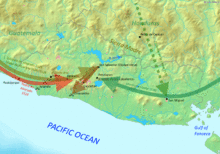Spanish conquest of El Salvador
Before the conquest the country formed a part of the Mesoamerican cultural region, and was inhabited by a number of indigenous peoples, including the Pipil, the Lenca, the Xinca, and Maya.
Native weaponry consisted of spears, bows and arrows, and wooden swords with inset stone blades; they wore padded cotton armour.
[2] Gonzalo de Alvarado founded San Salvador the following year, but it was eradicated by a native attack in 1526, during a general uprising that spread across the region.
In 1530, Pedro de Alvarado ordered the establishment of a new settlement at San Miguel, in the east of the country, to protect against further incursions from Nicaragua and to assist in the conquest of the surrounding area.
The conquistadores discovered that there was little gold or silver to be found in El Salvador, and it became a colonial backwater with a small Spanish population, within the jurisdiction of the Captaincy General of Guatemala.
Other indigenous groups with territories in El Salvador were the Ch'orti' and the Poqomam (both of these were Maya peoples), the Lenca, the Xinca, the Kakawira, the Mangue, and the Matagalpa.
Their weapons included long spears, atlatls (spear-throwers), arrows, and the macana (a wooden sword with inset obsidian blades similar to the Aztec macahuitl).
[14] After the first two large-scale battles between the Spanish and Pipil armies resulted in decisive victories for the European invaders, the natives preferred to flee their settlements at their approach rather than face the conquistadors on an open battlefield.
Private adventurers thereafter entered into contracts with the Spanish Crown to conquer the newly discovered lands in return for tax revenues and the power to rule.
[19] In the first two decades of the 16th century, the Spanish established their domination over the islands of the Caribbean Sea, and used these as a staging point to launch their campaigns of conquest on the continental mainland of the Americas.
[21] The Spanish heard rumours of the rich empire of the Aztecs on the mainland to the west of their Caribbean island settlements and, in 1519, Hernán Cortés set sail to explore the Mexican coast.
[24] The conquistadors were all volunteers, the majority of whom did not receive a fixed salary but instead a portion of the spoils of victory, in the form of precious metals, land grants and provision of native labour.
[27] A key strategy was the establishment of colonial towns across the territories that underwent the process of conquest and colonisation; they were used to project Spanish power over the surrounding countryside.
As important as the physical advantage given to a mounted conquistador was the ability to rapidly move bodies of troops across a battlefield to outmaneuver their opponents, who were exclusively on foot.
[35] Crossbows had 0.61-metre (2 ft) arms stiffened with hardwoods, horn, bone and cane, and supplied with a stirrup to facilitate drawing the string with a crank and pulley.
[41] Further waves of epidemic diseases spread across Mesoamerica in 1545–1548, and again in 1576–1581, reducing indigenous populations to just 10% of their pre-contact levels,[42] making successful resistance against the European colonisers extremely difficult.
In 1548, El Salvador was formally placed within the jurisdiction of the Audiencia Real of Guatemala, which extended along the Central American isthmus from Chiapas, now in southern Mexico, to Costa Rica.
[46] Pedro de Alvarado entered El Salvador from Guatemala in the rain season of 1524, leading an army of 250 Spaniards, 100 of which were mounted, and 5,000 Guatemalan allies.
[53] Alvarado rested two days at Tazuzcalco, before proceeding to Miahuaclan, which had been abandoned by its inhabitants, then on to Atehuan (modern Ateos, near the Pipil city of Cuzcatlan, capital of the province of the same name).
Messengers from the lords of Cuzcatlan brought promises of submission to the King of Spain, but when Pedro de Alvarado's army arrived at the city, he found that the majority of the inhabitants had fled.
[57] Frustrated by the lack of progress, Alvarado withdrew to Guatemala to regroup, with the intention of returning in the dry season;[43] He had been in the province of Cuzcatlan for seventeen days,[57] and left it at the end of June 1524.
[69] The uprising around San Salvador was put down about a month later, when the Spanish stormed the mountaintop stronghold at Cinacantan,[69] 5 kilometres (3.1 mi) south of the modern town of Tamanique.
[73] One of the native lords called a truce and asked the Spanish to return to San Salvador, and promised that the rebellious Indians would arrive to swear loyalty to the King of Spain.
[74] In 1529, Pedrarias Dávila sent an expedition led by Martín de Estete to annex the territory of El Salvador to his domains in neighbouring Nicaragua,[10] going so far as to distribute the unconquered natives of the Gulf of Fonseca in encomienda to his followers.
The residents of San Salvador rose up in arms to join the relief force; Estete abandoned his camp and retreated towards Nicaragua, taking with him 2,000 enslaved Cuzcatlecos.
He was challenged by Andrés de Cerezeda, governor of Honduras, and eventually marched south to San Miguel with his men,[79] bringing an urgently needed influx of new colonists.
After three days the attackers were repulsed by reinforcements that were passing through from Guatemala en route to Peru, with the help of a detachment from San Salvador under the command of Antonio de Quintanilla.
[85] The inhabitants of San Salvador, alarmed by the uprising engulfing the region, responded by sending a great quantity of weapons, armour, gunpowder, and other supplies to Francisco de Montejo in Honduras.
[87] By the end of 1538, Lempira's stronghold had been taken by the Spanish,[88] and Montejo crossed from Honduras to San Miguel to assist in putting down continued indigenous resistance in the district.
[92] The Annals of the Cakchiquels, an indigenous document from the Guatemalan Highlands, contains an account of Pedro de Alvarado's initial incursion into El Salvador.





